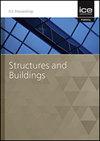Effect of loss of bond on the behaviour of RC beams under service loading conditions
IF 1.4
4区 工程技术
Q3 CONSTRUCTION & BUILDING TECHNOLOGY
Proceedings of the Institution of Civil Engineers-Structures and Buildings
Pub Date : 2022-11-01
DOI:10.1680/jstbu.22.00181
引用次数: 0
Abstract
The deviation of the flexural reinforcement spacing from code specifications appears to underly the causes of loss of bond between concrete and steel which preceded the unexpected collapse of the top-floor balcony of a building under service loading conditions on 15th October 2021 in Athens. Although rare, loss of bond has also been identified as the cause of collapse of buildings under similar conditions in the U.K. and Canada. Yet, Codes of Practice for reinforced concrete design neither make reference to the effect of loss of bond on structural behaviour, nor include loss of bond in the parameters which the formulae currently used for assessing load-carrying capacity are dependent on. In view of the above, the paper provides a description of the effect of loss of bond on the function of reinforced-concrete beams and this description is used as the basis for the derivation of a formula linking loss of bond with load-carrying capacity. The validity of the proposed formula is verified through the use of published experimental information on the subject and applied for the structural assessment of the collapsed balcony taking into account design details, physical state and loading conditions of structural members similar to that which collapsed.使用荷载条件下粘结损失对RC梁性能的影响
受弯钢筋间距与规范规范的偏差似乎是导致混凝土和钢材之间失去粘结的根本原因,导致2021年10月15日雅典一座建筑的顶楼阳台在服务荷载条件下意外倒塌。虽然很罕见,但在英国和加拿大,在类似的情况下,债券损失也被认为是导致建筑物倒塌的原因。然而,钢筋混凝土设计的实践规范既没有提及粘结损失对结构性能的影响,也没有将粘结损失包括在目前用于评估承载能力的公式所依赖的参数中。鉴于此,本文描述了粘结损失对钢筋混凝土梁性能的影响,并以此为基础推导了粘结损失与承载能力联系的公式。利用已发表的相关试验资料,验证了该公式的有效性,并将其应用于倒塌阳台的结构评估中,考虑了与倒塌相似的结构构件的设计细节、物理状态和荷载条件。
本文章由计算机程序翻译,如有差异,请以英文原文为准。
求助全文
约1分钟内获得全文
求助全文
来源期刊
CiteScore
3.40
自引率
6.20%
发文量
61
审稿时长
12 months
期刊介绍:
Structures and Buildings publishes peer-reviewed papers on the design and construction of civil engineering structures and the applied research associated with such activities. Topics include the design, strength, durability and behaviour of structural components and systems.
Topics covered: energy conservation, people movement within and around buildings, strength and durability of steel and concrete structural components, and the behaviour of building and bridge components and systems

 求助内容:
求助内容: 应助结果提醒方式:
应助结果提醒方式:


